Teresa González Díez
One of the most exclusive and least known stones to the public is alabaster. It is a very translucent material that allows backlighting, making it very attractive for interior decoration. It has been used since antiquity for the elaboration of decorative elements and nowadays it is used in construction as well as in interior decoration and furniture.
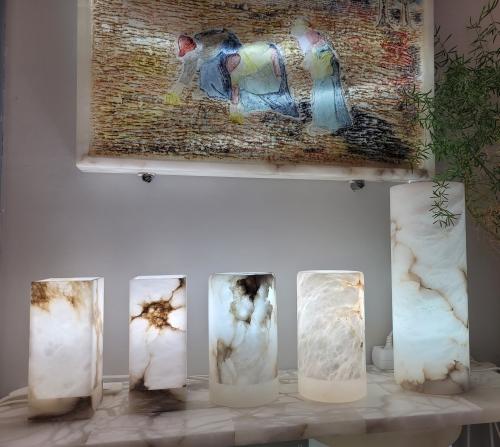
Photo: ALABASTRES JM SANAHUJA
Geologically, alabaster is a variety of pure and crystalline gypsum, a hydrated calcium sulphate. There are two types of alabaster, calcium alabaster and ‘gypsum’, the subject of this article, which has a compact appearance and is made up of small gypsum crystals. It is a soft material (hardness of 1.5 to 2 on the Mohs scale) which makes it easy to work although it scratches easily, however, if properly cared for, it is very durable.
Due to its fragility, a large part of the extracted material is discarded in the transformation processes, with 20-30% of the raw material obtained in the quarry being used for construction. The discarded material returns to the production chain to be converted into very white gypsum, fertilisers for agricultural land and for the purification of slurry waste water.
It does not stain or discolour and does not absorb liquids, however, it is sensitive to humidity and this can damage it, dissolving it. The natural colour of this material is mainly white, with some brown and reddish streaks, but there are also creams, pinks and browns. They can be found in other colours because, being a porous material, they can be coloured.
One of the main attractions of alabaster is that it is one of the most translucent materials in the world, which is why it is widely used for backlit decoration.
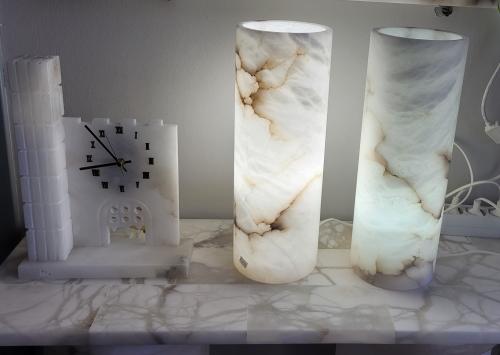
Photo: ALABASTRES JM SANAHUJA
Care and maintenance
Undoubtedly, alabaster requires special care. Aggressive chemicals and excess water should be avoided. A damp cloth is sufficient, and it should be dried immediately so that moisture does not penetrate the material. Direct exposure to sunlight causes alabaster to yellow over time and should therefore be avoided. It is recommended that a special wax be applied once a year to protect the alabaster and to enhance its shine.
Extraction and markets
There are alabaster deposits all over the world, but the most important and largest production sites are found in Spain, specifically in the Autonomous Community of Aragon in the areas known as the Ebro Valley (Lower Aragon) and the Jiloca Valley. The number of quarries that are currently active or in operation in Spain is six, and there are four workshops that work it, located in the towns of Sarral (Tarragona) and Cintruénigo (Navarra).
Alabaster can be found in Italy (Volterra), Iran, Turkey, Egypt, among other countries, but most of the alabaster marketed internationally comes from Aragon. The quality of Spanish alabaster is the best, because it is the most translucent.
Apart from being sold in Spain, it is mainly exported to Italy, China and India. China is currently the largest importer. 95% of the semi-finished alabaster is for international export. The price of alabaster depends on the size of the stone, since it is quarried in pellets; the larger the size, the more expensive it is.
Applications
The biggest problem with alabaster is that it is a little known material, not only by the public, but also by professionals in the construction sector. Despite this, there are some important works made with alabaster. For example, in the new Cathedral of Los Angeles (California, USA), 3,000 m2 of this stone were used, which makes this building the largest work made with alabaster. In Mexico, it can be found in the offices of the multinational 3M and in Beijing, in the China National Bank, where alabaster has been used in large quantities.
In Spain, the Aragon Pavilion at Expo 92 in Seville, the Auditorium in Zaragoza, the Caja General de Ahorros building in Granada, the sculptures on the façade of the Marqués de Dos Aguas in Valencia and the luminaires of the Sagrada Familia in Barcelona are other examples of the use of this decorative material in construction over the years.
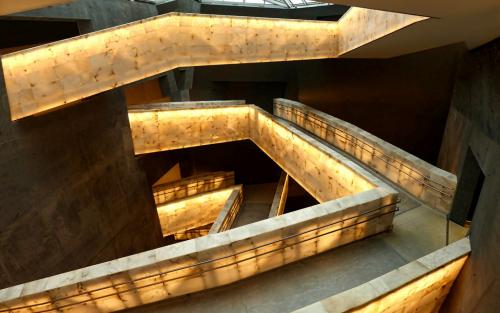
Photo: ALABASTER NEW CONCEPT
The application of alabaster in construction is basically in interiors, false ceilings, interior staircases, wall coverings and fronts with light, interior windows and room dividers. The size of the tiles is usually 30x15 cm, with a minimum thickness of 6 mm. Its installation is similar to that of glass and has more or less the same market as onyx, with the difference that alabaster is more translucent.
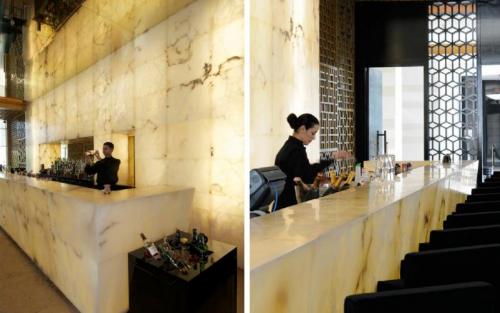
Hotel Sofitel. Photo: ALABASTER NEW CONCEPT
The first applications of this stone were for gift objects, plates, vases? Already in ancient times it was used in flasks for essences and perfumes or we can also find it in the canopic vases of Egyptian tombs and in sculptures of all types and cultures. Countries such as Egypt since the time of the Pharaohs, India or China have used and continue to value alabaster as an ornamental stone.
In Europe it was used extensively during the Middle Ages, at the height of the construction of great churches and cathedrals. Later it came to be used in lighting, lamps and sconces, which is still one of the main applications of alabaster today.
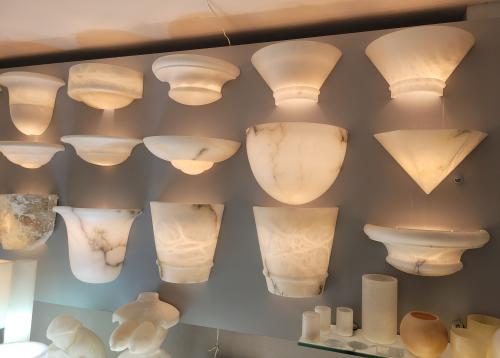

Alabaster sconces, candle holders and lamps. Photo: ALABASTRES JM SANAHUJA
Nowadays, with the boom in the application of natural stone in decoration, we find alabaster in furniture such as tables of all sizes, decorative seats, washbasins, countertops in bars and restaurants and reception desks in hotels and large companies.
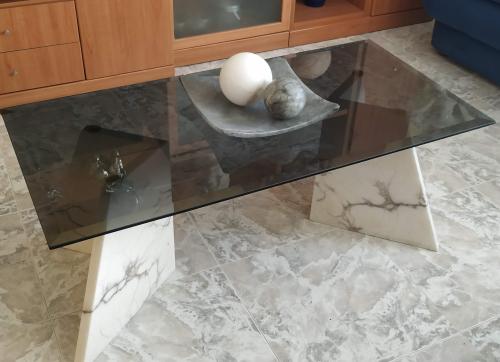
Photo: ALABASTRES JM SANAHUJA
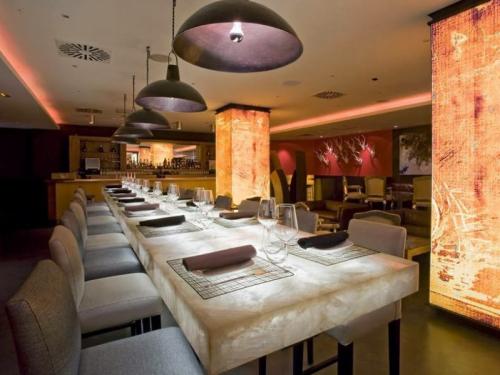
Photo: ALABASTER NEW CONCEPT
As with other stones, it may be only a matter of time and marketing before alabaster begins to occupy a more prominent place in the minds of professionals.
NOTE: we would like to thank Xavier Sanahuja, from Alabastres JM Sanahuja and Joan Corcelles, from Alabaster New Concept for their contributions to this article.
This article is an update of the report ‘The alabaster industry in Aragon’ published in the printed edition of LITOS nº 54 (May 2001).
